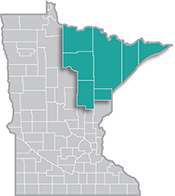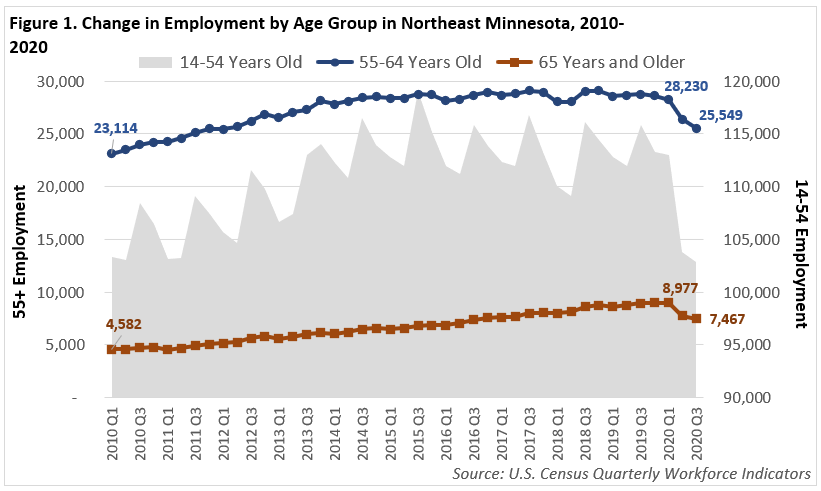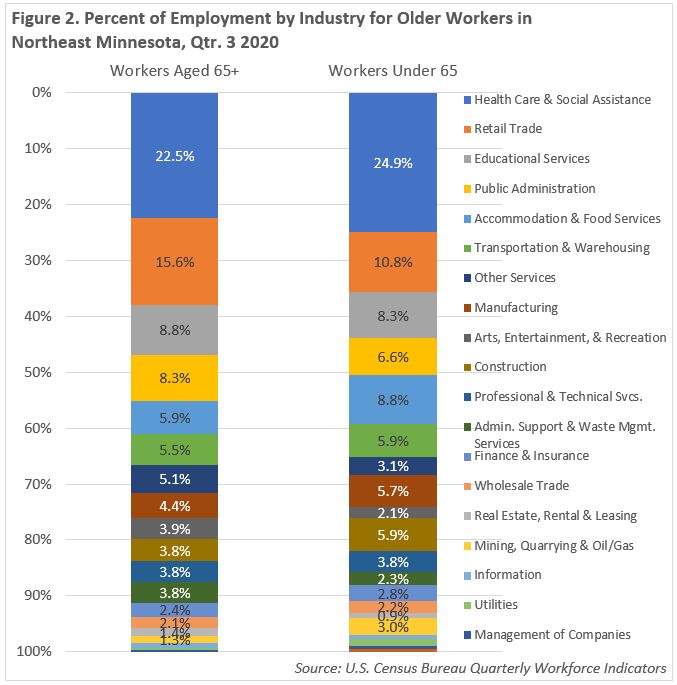 Home to the state's second-largest metro, the Northeast Region has a strong industrial sector, tied largely to the area's abundant natural resources.
Home to the state's second-largest metro, the Northeast Region has a strong industrial sector, tied largely to the area's abundant natural resources.
Most of the manufacturing base centers on mining and forest products industries. More than half of the sector's employment is in paper and machinery manufacturing.
Want the freshest data delivered by email? Subscribe to our regional newsletters.
8/30/2021 9:00:00 AM
Carson Gorecki
As Minnesota's population ages, older workers will play an increasingly important role in the workforce. But how has the expected future role of older workers been impacted by the pandemic-related recession? The answer to this question may be particularly important in Northeast Minnesota – a region with a population and workforce older than the state average.
As of 2019, residents aged 55 and over accounted for 24.7% of the labor force and 35% of the population in Northeast Minnesota. Since 2000, the 55 years and older population grew 39.8%, an increase of more than 34,000 people. Over the same period, the under 55 population shrank 13.5%, representing nearly 32,000 fewer people. This shift impacted not only the goods and services required by a changing population but also shaped the workforce available to provide them.
While older residents tend to have lower labor force participation rates, the number of jobs held by older workers has increased in recent pre-pandemic years at an even faster pace than the same aged population. Since the end of the Great Recession in 2010, employment in all age groups expanded 12.9%, but was led by growth in jobs held by those 65 and older, which nearly doubled through 2019 (see Figure 1). Despite this increase, the 65+ workforce still accounted for only 5.8% of total jobs in 2019. At the other end of the age spectrum, with an increase of 27.3%, workers aged 14-18 grew the second fastest, but represented only 3.2% of total jobs in 2019.

The adverse impacts of the coronavirus pandemic on employment were not distributed evenly across age groups. Data from the Census Bureau's Quarterly Workforce Indicators (QWI) program show that the oldest and youngest workers lost jobs at higher rates. In the 2nd quarter of 2020, the number of jobs held by workers 65 years and older was 11.1% lower than a year previous, surpassed only by the decrease of jobs held by workers 21 years and younger, which fell 12%. While employment for those 21 and under rebounded into the 3rd quarter, employment for those 65 years and older continued to decline by another 4.1%.
By comparison, during the Great Recession it was the oldest workers that fared the best in Northeast Minnesota, adding jobs where the other groups saw declines. Between 2008 and 2009, workers 65 and older filled 0.5% more jobs. Conversely, jobs held by workers 21 and younger declined 9.4% and total jobs fell 5.5%.
Many people have theorized that older workers opted for earlier retirement due to the coronavirus pandemic. Researchers at Boston College found that this was not necessarily the case, and perhaps not for the reasons you think. The impacts of the pandemic fell disproportionately on workers in lower wage occupations. Workers 65 and older are more likely to work in service-providing industries that pay lower wages such as Retail Trade, Arts, Entertainment and Recreation, and Other Services (see Figure 2). These workers are much less likely to have strong savings that would've allowed them to retire with a level of reasonable comfort.

Nevertheless, labor force participation for Americans 55 years and older is now 5.2% lower than in July of 2019. By comparison, labor force participation fell just 0.4% for the 25-54 year old age group. Some of those workers may have not retired but left the labor force for other reasons such as health concerns, including concerns over contracting COVID-19. These issues will need to be fully identified and addressed if older workers are to return to work.
The tight labor market conditions that prevailed prior to the pandemic have returned quickly. As a result, many employers find themselves desperate for workers and are increasingly exploring non-traditional sources. In the past 10 years, employers may have found themselves turning to older workers for reliability, experience, and talent. However, the loss of older workers due to COVID-19 has made an already shallow labor force pool dry up even more.
The fact that workers 65 years and older account for a small share of Northeast Minnesota's workforce could be an opportunity to encourage greater labor force participation in this age group. Increasing labor force participation for older workers would benefit employers and continue to work toward regional economic recovery.
Resources for older workers looking to return to the workforce:
Resources for employers looking to hire older workers:
Contact Northeast Minnesota Labor Market Analyst Carson Gorecki at 218-302-8413.